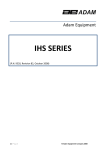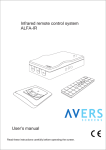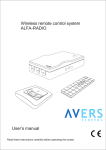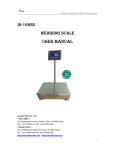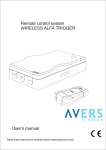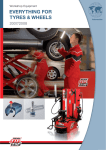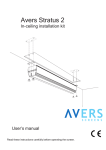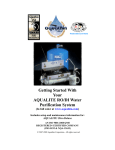Download AP Dynamometer Service Manual
Transcript
AP Dynamometer Service Manual 2 AP Dynamometer Service Manual AP Dynamometer Introduction .............................................................................................................................. 5 The Dillon Mechanical Dynamometer Family .................................................................................................. 5 About This Manual .......................................................................................................................................... 5 Disassembly and Reassembly .............................................................................................................................. 6 Separation of Pressure Bar and Gauge Movement on 5" Diameter Units up to 20,000 lb/10000 kg ............... 6 Reassembly of Pressure Bar and Gauge Movement on 5" Diameter Units up to 20,000 lb/10000 kg ............ 6 Separation of Pressure Bar and Gauge Movement on 10" Diameter Units up to 20,000 lb/10000 kg ............. 8 Reassembly of Pressure Bar and Gauge Movement on 10" Diameter Units up to 20,000 lb/10000 kg........... 8 Separation of Pressure Bar and Gauge Movement on 10" Diameter Units from 30,000 -100,000 lb (15000-50000 kg) Capacities ................................................................................... 9 Reassembly of Pressure Bar and Gauge Movement on 10" Diameter Units from 30,000 -100,000 lb (15000-50000 kg) Capacities ................................................................................... 9 Periodic Maintenance Requirements .................................................................................................................... 11 Cleaning And Lubrication ............................................................................................................................... 11 Inspection of the Pressure Bar ....................................................................................................................... 11 Inspection of the Shackles and Pins ..............................................................................................................12 Defect Removal Allowances for Shackles and Shackle Pins .........................................................................12 Defect Removal Allowances for Pressure Bars ..............................................................................................13 Proof Loading ................................................................................................................................................13 Calibration Procedures .........................................................................................................................................14 Procedure for 20,000 lb (10000 kg) and Below ..............................................................................................14 Span adjustment procedure ....................................................................................................................14 Procedure for 30,000 lb (15000 kg) and Higher .............................................................................................16 Span adjustment procedure ....................................................................................................................16 Pointer Part Numbers...........................................................................................................................................17 Standard 5” (127 mm) Dynamometer ............................................................................................................17 Standard 10” (254 mm) Dynamometer ..........................................................................................................17 Troubleshooting and Common Repairs ................................................................................................................18 Calculating Tension in a System ...........................................................................................................................18 5” Dial (500-20,000 lb Cap.) Parts and Assembly .................................................................................................19 10” Dial (500-20,000 lb Cap.) Parts and Assembly ...............................................................................................20 10” Dial (30,000-50,000 lb Cap.) Parts and Assembly ..........................................................................................21 10” Dial (100,000 lb Cap.) Parts and Assembly ....................................................................................................22 Shackle/Pin Dimensional Outline Drawings..........................................................................................................23 AP Dynamometer Service Manual 3 4 AP Dynamometer Service Manual The Dillon Mechanical Dynamometer Family The popular Dillon Model AP dynamometer is a rugged, robust self-contained and portable tension measuring instrument. Introduced in 1977, the Model AP is the most widely used dynamometer in the field today in countless different applications. The Dillon ProLift mechanical dynamometer supplemented the Dillon Model AP dynamometer in 2001. Designed with the input of nuclear fuel handlers, the ProLift satisfies all of the requirements for these ultra-sensitive applications. The ProLift offers the following enhancements over the Model AP: • 5:1 Ultimate safety factor in all capacities • Exclusive material selection • Rounded pressure bar ends • Electroless nickel plating • Non-destructive examination of 100% of pressure bars in all capacities • Non-destructive examination of 100% of low-capacity shackles and shackle pins • Proof-load tested to 150% of capacity • Anchor shackles in all capacities Dillon recommends that the ProLift should be the first choice when future periodic non-destructive examination or proof loading is required. These dynamometers are available in crane scale versions. These employ hooks at the lower end, the large 10-inch diameter dial and are shipped in plywood reinforced crates in all capacities. In addition, Dillon offers a popular electronic dynamometer family and other highly rated force measurement products. See www.dillon-force.com for more information. About This Manual This service manual contains information needed for maintenance of Dillon AP Dynamometers. Included in this manual are the following: • instructions for disassembly and reassembly • periodic inspection requirements and procedures • instructions for calibration and zero adjustments • technical illustrations Service details for the ProLift dynamometer can be found in the separate ProLift Dynamometer Service Manual. AP Dynamometer Service Manual 5 Separation of Pressure Bar and Gauge Movement on 5" Diameter Units up to 20,000 lb/10000 kg Reassembly of Pressure Bar and Gauge Movement on 5" Diameter Units up to 20,000 lb/10000 kg If you are installing a new pressure bar, be sure the capacity marking on the new bar matches the marking on the old bar. The capacity letter along with other numbers are located on the narrow side of the bar between the end of the radius and the end of the pressure bar. See Table 1 for a list of letters and capacities. 6 These steps cover disassembly of the 5" diameter units up to 20,000lb/ 10000kg capacity to remove the pressure bar. 1. Remove the three 6-32 x ¼ pan head bezel screws holding the bezel to the housing. 2. Lift off the bezel, crystal, and max hand assembly. 3. Remove two ¼-28 x ¾ socket head cap screws and two ¼ flat washers holding the housing to the pressure bar. 4. Remove two ¼-28 x ¾ socket head cap screws and two ¼ flat washers holding the gauge movement assembly. Set aside the gauge movement assembly with the dial inlay and pointer attached. 5. Remove two ¼-28 x ¾ socket head cap screws and two ¼ flat washers holding the zero adjust bracket. Set aside the zero adjust bracket assembly. 6. The pressure bar has four needle bearings. Remove the bearings with a mechanical press with the plunge ram within ½ degree of the bearing hole axis. Under no circumstances should the bearings be removed by impact. Take care that the plunger does not contact the sides of the bearing hole as you push out the bearing. These steps cover reassembly of the 5" diameter units up to 20,000lb/ 10000kg capacity. See Table 2 for a list of proper torque for the screws. 1. Reinsert the bearings with a mechanical press with the plunge ram within ½ degree of the bearing hole axis. Insure that the bearing hole, bearing outer surface and ram are all free of debris, dirt or particles. To facilitate bearing installation, an anti-seize compound such as FelPro C5-A may be used, provided any excess lubricant is wiped off after bearing installation. Carefully insert the bearings one at a time, insuring that the bearing remains properly aligned to the bearing hole axis. Reverse sides to install the second bearing. Always assembly the bearing with the stamped end against the shoulder of the pressing tool. 2. Attach the zero adjust bracket assembly and the gauge movement assembly with the four ¼-28 x ¾ socket head cap screws and four ¼ flat washers. 3. Install the dynamometer housing to the pressure bar with the two ¼-28 x ¾ socket head cap screws and two ¼ flat washers. 4. Install the bezel assembly to the housing with the three 6-32 x ¼ pan head bezel screws. 5. Reinstall shackles and/or hook assemblies. 6. Calibrate per procedures in the Calibration section of this manual. AP Dynamometer Service Manual Table 1 Pressure Bar Capacity Identification Helpful Unit Conversions: 1 lb = 0.4536 kg 1 kg = 2.205 lb 1 in = 2.540 cm 1 cm = 0.3937 in Capacity Range Capacity Length of Bar Letter/Number Low Low Low Low Low Low Low Low Med Med High High High High 500 LB 1,000 LB 2,000 LB 4,000 LB 5,000 LB 6,000 LB 8,000 LB 10,000 LB 15,000 LB 20,000 LB 30,000 LB 40,000 LB 50,000 LB 100,000 LB 8.8 in. 8.8 in. 8.8 in. 8.8 in. 8.8 in. 8.8 in. 8.8 in. 8.8 in. 8.8 in. 8.8 in. 15.1 in. 15.1 in. 15.1 in. 19.0 in. A B C D E F G H J K 1 2 3 1 Low Low Low Low Low Low Med High High High 200 KG 500 KG 1000 KG 2000 KG 4000 KG 5000 KG 10000 KG 15000 KG 20000 KG 50000 KG 22 cm 22 cm 22 cm 22 cm 22 cm 22 cm 22 cm 38 cm 38 cm 48 cm L M N P Q R S 4 5 2 Table 2 Recommended Torque Specifications Screw size Torque* 6-32 UNC 10-32 UNF ¼-28 UNF 10-12 in-lb 70 in-lb 144 in-lb * ± 5% AP Dynamometer Service Manual 7 Separation of Pressure Bar and Gauge Movement on 10" Diameter Units up to 20,000 lb/10000 kg Reassembly of Pressure Bar and Gauge Movement on 10" Diameter Units up to 20,000 lb/10000 kg If you are installing a new pressure bar, be sure the capacity marking on the new bar matches the marking on the old bar. The capacity letter along with other numbers are located on the narrow side of the bar between the end of the radius and the end of the pressure bar. See Table 1 for a list of letters and capacities. 8 These steps cover disassembly of the 10" diameter units up to 20,000lb/ 10000kg capacity to remove the pressure bar. 1. Remove the four 6-32 x ¼ pan head bezel screws holding the bezel to the housing. 2. Lift off the bezel, crystal, and max hand assembly. 3. Remove the pointer from the gauge movement shaft with a pointer puller (P/N 29945-0023). 4. Remove the three 6-32 x ¼ dial pan screw/washer assemblies. 5. Remove two ¼-28 x ¾ socket head cap screws and two ¼ flat washers holding the housing to the pressure bar. 6. Remove two ¼-28 x ¾ socket head cap screws and two ¼ flat washers holding the gauge movement assembly. Set aside the gauge movement assembly with the dial inlay and pointer attached. 7. Remove two ¼-28 x ¾ socket head cap screws and two ¼ flat washers holding the zero adjust bracket. Set aside the zero adjust bracket assembly. 8. The pressure bar has four needle bearings. Remove the bearings with a mechanical press with the plunge ram within ½ degree of the bearing hole axis. Under no circumstances should the bearings be removed by impact. Take care that the plunger does not contact the sides of the bearing hole as you push out the bearing. These steps cover reassembly of the 10" diameter units up to 20,000lb/ 10000kg capacity. See Table 2 for a list of proper torque for the screws. 1. Reinsert the bearings with a mechanical press with the plunge ram within ½ degree of the bearing hole axis. Insure that the bearing hole, bearing outer surface and ram are all free of debris, dirt or particles. To facilitate bearing installation, an anti-seize compound such as FelPro C5-A may be used, provided any excess lubricant is wiped off after bearing installation. Carefully insert the bearings one at a time, insuring that the bearing remains properly aligned to the bearing hole axis. Reverse sides to install the second bearing. Always assembly the bearing with the stamped end against the shoulder of the pressing tool. 2. Attach the zero adjust bracket assembly and the gauge movement assembly with the four ¼-28 x ¾ socket head cap screws and four ¼ flat washers. 3. Mount the dial pan over the pointer shaft and hold in place. 4 Support the bearing at the end of the pointer shaft to prevent it from pushing out. 5. Align the flats on the point to the shaft and install. Still supporting the bearing, tap lightly on the pointer button until the pointer is flush to the end of the shaft. 6. Turn this assembly onto the dial face you are still holding form step #3. 7. Install the dynamometer housing to the pressure bar with the two ¼-28 x ¾ socket head cap screws and two ¼ flat washers. 8. Install the dial pan with the three 6-32 x ¾ screw/washer assemblies. AP Dynamometer Service Manual Separation of Pressure Bar and Gauge Movement on 10" Diameter Units from 30,000 -100,000 lb (15000-50000 kg) Capacities It is helpful to be consistent in the location of the pressure bar. In the directions at right the dial pan is face up with the plate containing the serial number to the left and facing you. Reassembly of Pressure Bar and Gauge Movement on 10" Diameter Units from 30,000 -100,000 lb (15000-50000 kg) Capacities 9. Install the bezel assembly to the housing with the four 6-32 x ¼ pan head bezel screws. 10. Reinstall shackles and/or hook assemblies. 11. Calibrate per procedures in the Calibration section of this manual. 1. Remove the four 6-32 x ¼ pan head bezel screws holding the bezel to the pan. 2. Lift off the bezel, crystal, and max hand assembly. 3. Remove the pointer from the gauge movement shaft with a pointer puller (P/N 29945-0023). 4. Remove the four 10-32 x 3/8 socket head cap screws and flat washers from the two angle brackets holding on the dial pan cover plates. 5. Remove two ¼-28 x ¾ socket head screws, flat and lock washers from each of the ¼" thick side plates. The left plate contains the serial number and zero adjustment access hole. Leave the thin cover plates attached to these two plates. Note that the end of the two spacer plates are flush to the end of the ¼" thick plates. 6. Remove two ¼-28 x ½ socket head screws (no washers) from the ½" thick side plates. The left plate holds the zero adjust assembly. The right plate holds the gauge movement bracket assembly. Leave the thin cover plates attached to these two ½" thick plates. 7. Note that the pressure bar is located with the cutout away from the you and that the distance from the right end to the notch is 3 5/16". The distance from the left end to the notch is 3 9/16". This is important for correct assembly. 8. The shackles are each fitted with two needle bearings. Remove the bearings with a mechanical press with the plunge ram within ½ degree of the bearing hole axis. Under no circumstances should the bearings be removed by impact. Take care that the plunger does not contact the sides of the bearing hole as you push out the bearing. 1. Reinsert the bearings with a mechanical press with the plunge ram within ½ degree of the bearing hole axis. Insure that the bearing hole, bearing outer surface and ram are all free of debris, dirt or particles. To facilitate bearing installation, an anti-seize compound such as FelPro C5-A may be used, provided any excess lubricant is wiped off after bearing installation. Carefully insert the bearings one at a time, insuring that the bearing remains properly aligned to the bearing hole axis. Reverse sides to install the second bearing. Always assembly the bearing with the stamped end against the shoulder of the pressing tool. 2. Again, note that the pressure bar is located with the cutout away from the assembler and that the distance from the right end to the notch is 3 5/16". The distance from the left end to the notch is 3 9/16". 3. Install the left plate with the zero bracket to the pressure bar with the two ¼-28 X ½ socket head screws (no washers). Align this plate parallel to the pressure bar and torque. AP Dynamometer Service Manual 9 If you are installing a new pressure bar, be sure the capacity marking on the new bar matches the marking on the old bar. The capacity letter along with other numbers are located on the end of the bar with the 3 9/16" wide end. It is on the outside corner which is on the same side as the center cutout. The identifier is the far most right number in the string of numbers. See Table 1 for a list of letters and capacities. 10 4. Install the right plate with the gauge movement bracket assembly. Tip the plate downwards to engage the pressure arm into the zero adjust bracket. Do not force. Attach with the two ¼-28 X ½ socket head screws (no washers). Align this plate parallel to the pressure bar and torque. Note that the left plate is narrower than the right plate by .040" to clear the dial pan and eliminate interference during loading. 5. Install the right side ¼ inch thick cover plate with the spacer and attach with two ¼-28 X ¾ socket head screws, flat and lock washers and torque. The end of the spacer must be flush with the end of the plate. 6. Leave the remaining left ¼ inch thick cover plate and spacer until calibration is completed. 7. Attach the dial pan with the four 10-32 X 3/8 socket head screws and flat washers into the two angle brackets holding on the dial pan cover plates. Align the hole at the center of the dial face with the pointer shaft. Snug up the screws but do not tighten yet. 8. Align the flats and attach the pointer onto the gauge movement shaft by hand. Use a flat screwdriver end or similar device to reach into the housing to hold the lower shaft bearing from being driven out when setting the pointer to the shaft. Tap the pointer hub to the shaft until firm while holding the bearing from coming out. 9. While holding the pan, move the pointer clockwise at 90 degree increments to determine that it is centered to the pan and that the pan is uniform in height with the pointer. Now tighten the four socket head screws that hold the pan to the mounting covers. Recheck the pointer movement for interference and readjust if necessary. 10. Install the bezel to the pan with the four 6-32 X ¼ pan head screws. 11. Calibrate per the procedures in the Calibration section of this manual. 12. Now install the remaining ¼ inch serial I.D. cover plate with two ¼-28 X ¾ socket head screws, flat and lock washers and torque. Again, this plate has .040" more clearance to the dial pan than the adjoining plate. 13. When reinstalling the shackles and/or swivel hook, install the snap ring end of the 1" diameter mounting pin toward the dial side of the pressure bar. Install the roll pin with more clearance on the other end. AP Dynamometer Service Manual Cleaning And Lubrication Clean the bezel with a soft cloth dampened using ordinary glass cleaner. You can remove the bezel-retaining ring to clean the reverse side of the bezel. Remove the ring by removing the Phillips screws that secure it to the housing. The bezel edging material need not be removed for this cleaning. Take care not to bend or damage the max pointer during cleaning. Reassemble in reverse order from disassembly. Shackle-pin bearings should be cleaned if grease, grime or dirt is apparent in the bearings. With the shackles and pins removed, apply a universal cleaning degreaser (such as Blue Shower, CRC Heavy Duty Degreaser, Safety-Kleen Solvent, etc.) directly to the bearings. Manually turn the bearings and continue applying cleaner until traces of dirt disappears. Sparingly apply a light lubricant (such as Ace LPS2, Exxon Handy Oil, 3 in 1 oil, etc.) to coat all moving surfaces. The gearing works or mechanical mechanisms within the dynamometer housing can be cleaned with a cleaning degreaser and then sparingly lubricated with a light lubricant. The remainder of the dynamometer may be cleaned with a light-duty, general purpose cleaner. Inspection of the Pressure Bar In service, the pressure bar should not be permitted to contact or otherwise sustain impression or impact loads. Any pressure bar with cracks or sharp gashes should be immediately removed from service. Any pits, impressions, or other surface inconsistencies larger than 0.031 (1/32) inch are cause for replacement. Smooth or rounded imperfections with depths less than 0.062 (1/16) inch are permissible on the corners indicated in the illustration at right. Scratches across the bearing hole greater than 0.005 inch in depth are cause for replacement. Machining marks running the circumference of the bearing hole are not cause for rejection. Under no circumstances should any surface of the pressure bar be subjected to grinding. The pressure bar cannot be repaired by welding. For organizations that perform periodic nondestructive testing of the pressure bar, relevancy checks may be performed using a Dremmel type tool and fine grit drum, flexible disc, or buffer type attachments, such that the resulting finish is no worse than 63 micro inches and the depth is not greater than 0.005 inches. Any one location may only be relevancy checked once during the lifetime of the pressure bar. Relevancy checks may not be performed in the area of the stamped traceability numbers. AP Dynamometer Service Manual 11 Inspection of the Shackles and Pins The shackles and pins that are supplied with the AP dynamometer are produced to tight tolerances to mate with the AP components in order to maintain the accuracy specifications of the instrument. Substitution, elimination or improper replacement of these components can result in substandard performance and possible safety issues. Wear of shackles Shackles showing a wear reduction due to use that reduces any nominal dimension of the shackle by five percent (5%) or pin by more than 2.5 percent (2.5%) shall be permanently removed from service. For units up to 20,000 lbs, shackle pins found to have needle bearing impression marks not greater than 0.004 inch deep are acceptable provided the dynamometer calibrates satisfactorily. If the impression marks are greater than 0.004 inch deep, the pin shall be permanently removed from service. Deformation of shackles Shackles that are determined to have been deformed (aside from local distortion at contact sites) shall be permanently removed from service. Any visually apparent bending or twisting out of the natural plane of the shackle or any distortion of nominal shackle profile (beyond the localized wear found at the shackle loading point) is cause for permanent removal from service Any shackles or pins that have a combination of wear and ground out areas that exceed the above stated percentages should be removed from service. Repair by means of welding is prohibited. Defect Removal Allowances for Shackles and Shackle Pins After grinding, apply suitable corrosion protection to the shackles. The maximum cross sectional area reductions for the shackles and shackle pins are 10% and 5% respectively. The nominal dimension removal allowances noted above will insure that the cross sectional areas remain within permissible range. 12 You may remove small defects from Dillon shackle assembles by grinding but care must be taken to keep the removal of material to a minimum. This section gives you guidelines on this procedure. You may grind the following Dillon shackle assemblies: • P/N 30010-0013—Anchor shackle • P/N 33202-0015—up to 15,000 lb oversize • P/N 33202-0023—20,000 lb 5:1 oversized • P/N 30371-0016—30,000 lb through 50,000 lb standard • P/N 30332-0014—100,000 lb Discontinuities that run parallel to the contour of the shackle or pin are usually not serious and do not need removal. Discontinuities that are transverse to the contour of the shackle or pin are more serious and may reduce longevity of the shackle or pin. Items with apparent cracks in any direction should be removed from service immediately. Discontinuities may be removed by grinding longitudinally following the contour of the shackle or pin producing a smooth undulating surface. The ground area must have a smooth blended transition with adjacent surfaces and a minimum taper of 3:1. No more than 0.06 inches (1.5mm) of material should be removed in depth and should not reduce any nominal dimension of the shackle by five percent (5%) or pin by more than 2.5 percent (2.5%). Grinding in the roller-bearing contact area of the shackle pin is not authorized, as a smooth and round surface is required for proper dynamometer performance. Re-inspection is required after grinding to determine if the original discontinuities were relevant. Shackles showing a wear reduction due to use that reduces any nominal dimension by more than 5% or the pin by more than 2.5% shall be permanently removed from service. AP Dynamometer Service Manual Defect Removal Allowances for Pressure Bars After grinding, apply suitable corrosion protection to the pressure bars. Minor scratches and dents may be removed from AP Dynamometer pressure bars using the following criteria and guidelines: 1. This type of action may not take place in any one location more than once during the life of the unit. Use a Dremmel type drum, flexible disk, or buffer attachments to remove scratches and dents. No more than .005 inch may be removed from the surface of the pressure bar. 2. The grit of the tool must be fine enough that the result is no worse than a 63 microinch surface finish. 3. On square corners, material may be removed to a depth of 1/16 inch as measured from the corner, due to these areas being at very low stress levels during use. Blunt dents less than 1/16 inch deep from the corner do not require removal for safe operation. 4. The serial number and traceability information is stamped near one of these low stress corners. Do not use a material removal tool in the area of these stamped numbers in order to maintain traceability. Repair by welding is not authorized. Proof Loading The Dillon Model AP mechanical dynamometer may be subjected to 150% proof loads of the rated capacity up to twice per year for inspection purposes. The applied loads must not exceed 155% of capacity of the instrument. The load may be held for any period desired provided the load does not cycle or vary. The proof load must be conducted in a controlled area with appropriate safety mechanisms in place. The dynamometer itself should not provide the load reference during the test. Original shackle pins should not be proof loaded on the 15,000-lb, 20,000-lb and 10000-kg Model AP dynamometers with the standard anchor shackle. The bearings can apply impressions to the shackle pins that can negatively affect performance. Substitute shackle pins should be used in proof loading to eliminate potential for distorting these pins. Shackle pins that require testing should be proof loaded independently in a fixture with smooth contact surfaces. The dynamometers will not experience mechanical damage under a 150% proof load, however the calibration and zero reference point may be altered. Recalibration will restore the original performance. AP Dynamometer Service Manual 13 Procedure for 20,000 lb (10000 kg) and Below Typical recalibration interval is every 12 months, although more frequent calibration is suggested for dynamometers in extreme service. Only Dillon shackles and pins should be used with the dynamometer during calibration or use. For best instrument performance, use the shackles and pins during calibration that are used during routine use. The shackle bearings included with the dynamometer must be used during calibration and operation. These bearings are installed in the dynamometer and facilitate predictable and repeatable rotational movement of the pressure arm under load. We do not recommend that the instruments be calibrated or have any type of performance reviewed with the bearings removed. Span adjustment procedure 14 Equipment required: • load frame, dead weights, or lever system • applicable fixturing for applying load to the device • torque wrench with 3/16 inch hex drive socket The calibration technician must be qualified for and trained in the procedures for operating the calibration machine, adjusting the calibration of the device, and recording of the calibration data. 1. Service the dynamometer. Inspect the unit for damage, and the condition of all load bearing surfaces. Replace or repair parts and assemblies as required. Leave the crystal off the unit until the device has been recalibrated after repair. 2. Dynamometers received for recalibration and repair that are functional should have “as found” readings taken. Install the dynamometer and shackles in the calibration machine. 3. Check the maximum hand adjustment and record the number of divisions to the nearest half division the maximum hand will move the dynamometer pointer in a counter clockwise direction. 4. Exercise the unit three times by applying 1.00 to 1.05 times rated capacity load and then releasing the load completely. Observe the smoothness of pointer travel throughout the full range. Zero the pointer and calibration transfer standard indicator. 5. Apply four to five point calibration with the pointer and division mark aligned at each reading as found. 6a. Apply the rated capacity load with the unit pointer and division mark aligned. Move the zero adjusting bracket towards the center of the unit if the load shown on the calibration machine indicator is greater than the rated dynamometer load. Move the bracket away from the center of the unit if the load shown on the calibration machine indicator is less than the rated dynamometer load. Repeat this procedure until the unit is properly spanned. 6b. Tighten the zero adjustment bracket cap screws to 144 +/- 8 inch pounds torque. 7a. Linearity adjustment procedure. Slight adjustments can be made to the midrange readings of the dynamometer. 7b. Loosen the two dial retaining screws. Load the dynamometer until the pointer and the one half of rated capacity division mark are aligned. Shift the bottom of the dial to the right if the load shown on the calibration machine indicator is greater than the half scale dynamometer load. Shift the bottom of the dial to the left if the load shown on the calibration machine indicator is less than the half scale dynamometer load. 7c. Tighten the two dial retaining screws and recheck the span adjustment of the unit. Readjust the unit span and linearity as required. AP Dynamometer Service Manual 8. Install the maximum pointer assembly, bezel, and housing on the dynamometer. Check the maximum hand adjustment. The maximum hand turned counter clockwise must not move the dynamometer pointer more than one division before the clutch mechanism slips. Readjust the clutch mechanism as required. 9. Affix a calibration cover label seal over the zero adjusting bracket access hole as required. Remove the dynamometer and any shackles from the calibration standard machine. 10. Verify the calibration entries satisfy the dynamometer accuracy specification. Enter the dynamometer serial number, the verified accuracy tolerance percentage, sign, and date the certificate of calibration card. AP Dynamometer Service Manual 15 Procedure for 30,000 lb (15000 kg) and Higher Typical recalibration interval is every 12 months, although more frequent calibration is suggested for dynamometers in extreme service. Only Dillon shackles and pins should be used with the dynamometer during calibration or use. For best instrument performance, use the shackles and pins during calibration that are used during routine use. Equipment required: • load frame, dead weights, or lever system • applicable fixturing for applying load to the device • torque wrench with 3/16 inch hex drive socket The calibration technician must be qualified for and trained in the procedures for operating the calibration machine, adjusting the calibration of the device, and recording of the calibration data. You should have assistance from the department or other areas in manipulating large heavy dynamometer assemblies into and out of the calibration machine. 1. Service the dynamometer. Inspect the unit for damage, and the condition of all load bearing surfaces. Replace or repair parts and assemblies as required. Leave the crystal off the unit until the device has been recalibrated after repair. Leave the serial plate cover off the unit. The shackle bearings included with the dynamometer must be used during calibration and operation. These bearings are installed in the dynamometer and facilitate predictable and repeatable rotational movement of the pressure arm under load. We do not recommend that the instruments be calibrated or have any type of performance reviewed with the bearings removed. 2. Dynamometers received for recalibration and repair that are functional should have “as found” readings taken. Install the dynamometer and shackles in the calibration machine. 3. Check the maximum hand adjustment and record the number of divisions to the nearest half division the maximum hand will move the dynamometer pointer in a counter clockwise direction. 4. Exercise the unit three times by applying 1.00 to 1.05 times rated capacity load and then releasing the load completely. Observe the smoothness of pointer travel throughout the full range. Zero the pointer and calibration transfer standard indicator. 5. Apply four to five point calibration with the pointer and division mark aligned at each reading. Span adjustment procedure 6a. Apply the rated capacity load with the unit pointer and division mark aligned. Move the zero adjusting bracket towards the center of the unit if the load shown on the calibration machine indicator is greater than the rated dynamometer load. Move the bracket away from the center of the unit if the load shown on the calibration machine indicator is less than the rated dynamometer load. Repeated this procedure until the unit is spanned. 6b. Tighten the zero adjustment bracket cap screws to 144 +/- 8 inch pounds torque. 7. Linearity adjustment procedure. Slight adjustments can be made to the midrange readings of the dynamometer. 8a. Loosen the two dial retaining screws. Load the dynamometer until the pointer and the one half of rated capacity division mark are aligned. Shift the bottom of the dial to the right if the load shown on the calibration machine indicator is greater than the half scale dynamometer load. Shift the bottom of the dial to the left if the load shown on the calibration machine indicator is less than the half scale dynamometer load. 8b. Tighten the two dial retaining screws and recheck the span adjustment of the unit. Apply five point calibration with the pointer and division mark aligned at each reading. Readjust the unit span and linearity as required. 16 AP Dynamometer Service Manual Standard 5” (127 mm) Dynamometer All capacities through 20,000 lb, 10000 kg, & 100K newtons 9. Install the maximum pointer assembly, bezel, and serial plate cover on the dynamometer. Check the maximum hand adjustment. The maximum hand turned counter clockwise must not move the dynamometer pointer more than one division before the clutch mechanism slips. Readjust the clutch mechanism as required. 10. Apply five point calibration with the pointer and division mark aligned at each reading. 11. Remove the dynamometer and shackles from the calibration standard machine. 12. Verify the calibration data satisfy the dynamometer accuracy specification. Enter the dynamometer serial number, the verified accuracy tolerance percentage, sign, and date the certificate of calibration card. There are four different main pointers for the AP Dynamometers (black). To determine which pointer you need, you must know where the zero is located on the dial. See illustration below. 12:00 = PN 30246-0019 3:00 = PN 30246-0027 6:00 = PN 30246-0035 9:00 = PN 30246-0043 Figure 1 5" dials Standard 10” (254 mm) Dynamometer There are four different main pointers for the AP Dynamometers (black). To determine which pointer you need, you must know where the zero is located on the dial. See illustration below. All capacities through 20,000 lb, 10000 kg, & 100K newtons 12:00 = PN 30079-0011 30,000 through 100,000 lb, use PN 30079-0029 3:00 = PN 30079-0029 6:00 = PN 30079-0037 9:00 = PN 30079-0045 Figure 2 10" dials AP Dynamometer Service Manual 17 Common Symptoms Probable Causes Suggested Repair Nonlinear Bent bar Worn gauge movement Replace pressure bar Replace gauge movement Won’t repeat Bad bar bearings (worn, rusty, or dirty) Worn gauge movement Replace bearings in pressure bar Replace gauge movement High on low end, low on high end Bad pressure arm Replace gauge movement Max hand will not rotate smoothly Spring too tight or rusty/corroded Replace max hand assembly Pointer jumps Bearings or pointer rubbing on dial face Clean bearings, 1 drop LPS on bearing, or replace gauge movement The setup shown above will give you an approximate tension reading. This can vary from actual tension due to variables in equipment and environment. 18 AP Dynamometer Service Manual AP DYNAMOMETER W/ 5” DIAL 500 - 20,000 lb / 200 – 10,000 kg CAPACITY PARTS and ASSEMBLY ITEM NO. 1 DESCRIPTION W-T P/N QTY 500 lb AP Pressure Bar Assembly 1,000 lb AP Pressure Bar Assembly 2,000 lb AP Pressure Bar Assembly 4,000 lb AP Pressure Bar Assembly 5,000 lb AP Pressure Bar Assembly 6,000 lb AP Pressure Bar Assembly 8,000 lb AP Pressure Bar Assembly 10,000 lb AP Pressure Bar Assembly 15,000 lb AP Pressure Bar Assembly 20,000 lb AP Pressure Bar Assembly 200 kg AP Pressure Bar Assembly 500 kg AP Pressure Bar Assembly 1,000 kg AP Pressure Bar Assembly 2,000 kg AP Pressure Bar Assembly 4,000 kg AP Pressure Bar Assembly 5,000 kg AP Pressure Bar Assembly 10,000 kg AP Pressure Bar Assembly 30005-0010 30005-0028 30005-0036 30005-0044 30005-0051 30005-0069 30005-0077 30005-0085 30005-0093 30005-0101 30005-0143 30005-0135 30005-0150 30005-0127 30005-0168 30005-0176 30005-0119 1 1 1 1 1 1 1 1 1 1 1 1 1 1 1 1 1 2 Cap Screw, ¼” x 1” L (sst) 26367-5639 2 3 Pan HD Screw, #6-32 x ¼” L 26380-0021 3 4 Cap Screw, ¼” x 3/4” L (sst) 26368-0068 4 5 Shackle Pin 30039-0010 2 6 Needle Bearings (used with items 7 & 10 only) 30385-00104 4 7 Shackle (standard size) 30038-0011 2 8 Hex Nut 14507-0140 2 9 Cotter Pin, (5/32” x 1 ¼” L) 14448-0209 2 10 Over Size Shackle, 15,000 lb or less (Optional) 29286-00462 2 11 Dillon Label 45150-0011 1 12 Cotter Pin, (¼” x 1 ½” L) 14448-0324 2 13 Flat Washer 33636-0029 4 14 Shackle Pin 30363-0024 2 15 Retaining Ring 15931-0028 2 16 Inner Race 26386-0025 4 17 Needle Bearing 26385-0166 4 18 Over Size Shackle, 20,000 lb (Optional) 29286-0020 2 19 Housing (plastic) 46835-0012 1 20 Flat Washer, ¼” 26431-0509 6 21 Max Hand Crystal Assy (incl: reset knob, crystal, max hand, spring, clip, etc.) Max Hand Assy (w/o crystal) 30030-0027 30032-0017 1 1 22 Bezel (plastic) 30011-0020 1 23 Spacer (top) 30018-0015 1 24 Rubber Gasket 30012-0011 1 25 Gauge Movement Assy 30040-0025 1 1 26 Zero Adjust Bracket Assy (w/ knob) 30019-0014 27 Dial Pointer (5”) 30246-0043 1 28 Spacer (0.0598” thk.) Spacer (0.006” thk.) Spacer (0.002” thk.) 30016-0017 30014-0019 30017-0016 AR AR AR 29 Instruction & serial no. Nameplate 30082-0016 1 30 Rivet 22382-0051 4 31 Dial Mounting Plate 47079-0015 1 32 Screw, #6 x .31”L 26371-0238 2 33 Screw, #6 x .19”L 15710-0215 2 19 AP DYNAMOMETER W/ 10” DIAL 500 - 20,000 lb / 200 – 10,000 kg CAPACITY PARTS and ASSEMBLY ITEM NO. 20 DESCRIPTION W-T P/N 30005-0010 30005-0028 30005-0036 30005-0044 30005-0051 30005-0069 30005-0077 30005-0085 30005-0093 30005-0101 30005-0143 30005-0135 30005-0150 30005-0127 30005-0168 30005-0176 30005-0119 QTY 1 500 lb AP Pressure Bar Assembly 1,000 lb AP Pressure Bar Assembly 2,000 lb AP Pressure Bar Assembly 4,000 lb AP Pressure Bar Assembly 5,000 lb AP Pressure Bar Assembly 6,000 lb AP Pressure Bar Assembly 8,000 lb AP Pressure Bar Assembly 10,000 lb AP ressure Bar Assembly 15,000 lb AP Pressure Bar Assembly 20,000 lb AP Pressure Bar Assembly 200 kg AP Pressure Bar Assembly 500 kg AP ressure Bar Assembly 1,000 kg AP Pressure Bar Assembly 2,000 kg AP Pressure Bar Assembly 4,000 AP Pressure Bar kg Assembly 5,000 kg AP Pressure Bar Assembly 10,000 kg AP Pressure Bar Assembly 1 1 1 1 1 1 1 1 1 1 1 1 1 1 1 1 1 2 Cap Screw, ¼” x 1” L (sst) 26367-5639 2 3 Pan HD Screw, #6-32 x ¼” L 26380-0021 7 4 Cap Screw, ¼” x 3/4” L (sst) 26368-0068 4 5 Shackle Pin 30039-0010 2 6 Needle Bearings (used with items 7 & 10 only) 30385-00104 4 7 Shackle (standard size) 30038-0011 2 8 Hex Nut 14507-0140 2 9 Cotter Pin, (5/32” x 1 ¼” L) 14448-0209 2 10 Over Size Shackle, 15,000 lb or less (Optional) 29286-0046 2 1 11 Dillon Label 45150-0011 12 Cotter Pin, (¼” x 1 ½” L) 14448-0324 2 13 Flat Washer 33636-0029 4 2 14 Shackle Pin 30363-0024 15 Retaining Ring 15931-0028 2 16 Inner Race 26386-0025 4 17 Needle Bearing 26385-0166 4 18 Over Size Shackle, 20,000 lb (Optional) 29286-0020 2 19 Housing (standard) 30013-0010 1 20 Flat Washer, ¼” 26431-0509 6 21 Max Hand Crystal Assy (incl: reset knob, crystal, max hand, spring, clip, etc.) 30093-0013 1 22 Bezel 30099-0017 1 23 Spacer 30018-0015 1 24 Dial Case Assembly 30359-0012 1 25 Rubber Gasket 30012-0029 1 26 Gauge Movement Assy 30040-0017 1 27 Zero Adjust Bracket Assy (w/ knob) 30019-0014 1 28 Max Hand Assy (w/o crystal) 30096-0010 1 AP DYNAMOMETER W/ 10” DIAL 30,000 - 50,000 lb / 15,000 – 20,000 kg CAPACITY PARTS and ASSEMBLY ITEM NO. 1 DESCRIPTION W-T P/N 30,000 lb AP Pressure Bar Assembly 30364-0015 QTY 1 40,000 lb AP Pressure Bar Assembly 30364-0023 1 50,000 lb AP Pressure Bar Assembly 30364-0031 1 15,000 kg AP Pressure Bar Assembly 30364-0049 1 1 20,000 kg AP Pressure Bar Assembly 30364-0056 2 Cap Screw, ¼” x 1” L 26367-5639 2 3 Pan HD Screw/Washer Assy, #6-32 x ¼” L 26380-0021 8 4 4 Cap Screw, ¼” x 3/4” L 26368-0068 5 Shackle Assy w/ Bearings 30371-0016 2 6 Rubber Gasket 30012-0029 1 7 Shackle 30038-0011 2 8 Lock Washer 14474-0198 6 9 Cover Plate (LH) 30176-0013 1 10 Cap Screw, #10 x 3/8”L 26367-5472 4 11 Lock Washer, #10 14474-0057 4 2 12 Cotter Pin, (¼” x 1 ½” L) 14448-0324 13 Flat Washer 30366-0013 4 14 Shackle Pin 30363-0016 2 15 Retaining Ring 15931-0028 2 16 Inner Race 26389-0105 4 17 Needle Bearing (heavy duty) 26388-0015 4 19 Cover Plate (RH) 30175-0014 1 20 Flat Washer, ¼” 26431-0509 6 21 Max Hand Crystal Assy (incl: reset knob, crystal, max hand, spring, clip, etc.) 30093-0013 1 22 Bezel 30099-0017 1 23 Spacer 30018-0015 1 24 Cover, Top & Bottom 35030-0018 4 25 Cap Screw, ¼” x 1 ¼”L 26367-5647 2 26 Dial Housing Assy 30368-0011 1 27 Gage Movement Mtg Bracket 30178-0011 1 1 28 Zero Adjust Mtg Bracket 30177-0012 29 Cap Screw, ¼” x ½”L 26368-0043 4 30 30K Gauge Movement Assy 30184-0013 1 40K Gauge Movement Assy 30184-0021 1 50K Guage Movement Assy 30184-0039 1 31 Zero Adjust Bracket Assy (w/ zero adjust screw) 35026-0014 1 32 Max Hand Assy (w/o crystal) 30096-0010 1 21 AP DYNAMOMETER W/ 10” DIAL 100,000 - 50,000 lb CAPACITY PARTS and ASSEMBLY ITEM NO. DESCRIPTION W-T P/N 50,000 kg AP Pressure Bar Assembly 30330-0024 1 100,000 lb AP Pressure Bar Assembly 30330-0016 1 2 Cap Screw, ¼” x 1” L 26367-5639 4 3 Pan HD Screw/Washer Assy, #6-32 x ¼” L 26380-0021 8 4 1 22 QTY 4 Cap Screw, ¼” x 3/4” L 26368-0068 5 Shackle Assy w/ Bearings 30326-0012 2 6 Rubber Gasket 30012-0029 1 2 7 Shackle 30038-0011 8 Lock Washer 14474-0198 6 9 Cover Plate (LH) 30314-0016 1 10 Cap Screw, #10 x 3/8”L 26367-5472 4 11 Lock Washer, #10 14474-0057 4 2 12 Cotter Pin, (¼” x 1 ½” L) 14448-0415 13 Flat Washer 30316-0014 4 14 Shackle Pin 30313-0017 2 15 Retaining Ring 15931-0069 2 16 “Top” label (identifies pin that must remain TOP) 33163-0012 1 17 Needle Bearing (heavy duty) 26388-0106 4 18 Inner Race (for item 17) 26389-0261 4 19 Cover Plate (RH) 30315-0015 1 20 Flat Washer, ¼” 26431-0509 8 21 Max Hand Crystal Assy (incl: reset knob, crystal, max hand, spring, clip, etc.) 30093-0013 1 22 Bezel 30099-0017 1 23 Spacer 30018-0015 1 24 Cover, Top & Bottom 35030-0026 4 25 Cap Screw, ¼” x 1 ¼”L 26367-5647 2 26 Dial Housing Assy 30108-0016 1 27 Gage Movement Mtg Bracket 30323-0015 1 28 Zero Adjust Mtg Bracket 30318-0012 1 29 Cap Screw, ¼” x ½”L 26368-0043 4 30 Gauge Movement Assy 30184-0047 1 31 Zero Adjust Bracket Assy (w/ zero adjust screw) 35026-0014 1 32 Max Hand Assy (w/o crystal) 30096-0010 1 33 Wooden Storage Box for each shackle (not shown) 30329-0019 2 34 Wooden Box for Dynamometer (not shown) 30328-0010 1 AP DYNAMOMETER SHACKLE / PIN DIMENSIONAL OUTLINE DRAWINGS 23 AP DYNAMOMETER SHACKLE / PIN DIMENSIONAL OUTLINE DRAWINGS 24

























